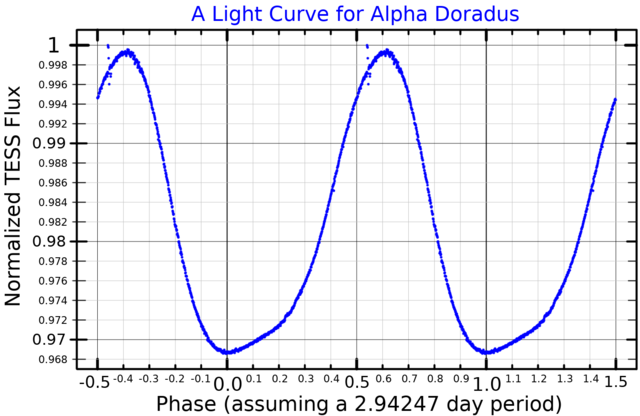Alpha Doradus, Latinized from α Doradus, is the brightest star in the southern constellation of Dorado. The distance to this system, as measured using the parallax method, is about 169 light-years (52 parsecs).[6]
 A light curve for Alpha Doradus, plotted from TESS data[10][11]
A light curve for Alpha Doradus, plotted from TESS data[10][11]
Quick Facts Apparent magnitude (V), Characteristics ...
Alpha Doradus
Location of α Doradus (circled) |
Observation data
Epoch J2000.0 Equinox J2000.0 (ICRS) |
| Constellation |
Dorado |
|
| A |
| Right ascension |
04h 33m 59.778s |
| Declination |
−55° 02′ 41.91″[1] |
| Apparent magnitude (V) |
3.27[2] |
| B |
| Right ascension |
04h 33m 59.782s |
| Declination |
−55° 02′ 42.39″[3] |
| Apparent magnitude (V) |
4.3[2] |
| Characteristics |
|
|
|
|
|
|
|
|
|
|
| U−B color index |
−0.35[2] |
| B−V color index |
−0.10[2] |
|
| R−I color index |
−0.09[2] |
|
|
|
|
|
|
|
|
|
|
|
|
|
|
|
|
|
|
|
|
|
| A |
|
| Spectral type |
A0IIIp[2] |
|
|
|
|
|
|
|
|
|
|
|
|
|
|
| Variable type |
ACV[4] |
|
|
|
|
|
|
|
|
|
|
|
|
|
|
|
|
|
|
| B |
|
| Spectral type |
B9IV[2] |
|
|
|
|
|
|
|
|
|
|
|
|
|
|
|
|
|
|
|
|
|
|
|
|
|
|
|
|
|
|
|
|
| Astrometry |
|---|
| A |
|---|
| Radial velocity (Rv) | 25.6 ± 0.9[5] km/s |
| Proper motion (μ) | RA: 58.06[1] mas/yr
Dec.: 12.73[1] mas/yr |
| Parallax (π) | 19.34±0.31 mas[6] |
| Distance | 169 ± 3 ly
(51.7 ± 0.8 pc) |
| B |
|---|
| Proper motion (μ) | RA: 42.83[3] mas/yr
Dec.: 12.94[3] mas/yr |
| Orbit[7] |
|---|
| Period (P) | 12.1 y |
| Semi-major axis (a) | 0.18″ |
| Eccentricity (e) | 0.80 |
| Inclination (i) | 31° |
| Longitude of the node (Ω) | 140° |
| Periastron epoch (T) | B1986 |
Argument of periastron (ω)
(secondary) | 193° |
| Details |
|---|
| A |
|---|
| Mass | 3.33 ± 0.10[8] M☉ |
| Radius | 3.5 ± 0.3[8] R☉ |
| Luminosity (bolometric) | 195[8] L☉ |
| Surface gravity (log g) | 4.02 ± 0.07[8] cgs |
| Temperature | 11,588[8] K |
| Rotation | 2.94 days[8] |
| B |
|---|
| Mass | 2.7[9] M☉ |
| Radius | 1.9[9] R☉ |
| Luminosity (bolometric) | 70[9] L☉ |
| Temperature | 12,200[9] K |
| Other designations |
|---|
| α Dor, Alpha Doradus, Alpha Dor, CD−55 916, CPD−55 663, FK5 171, GC 5600, HD 29305, HIP 21281, HR 1465, SAO 233564, PPM 333592, CCDM J04340-5503AB, WDS 04340-5503AB[5] |
| Database references |
|---|
| SIMBAD | data |
Close
This is a binary star system[9] with an overall apparent visual magnitude that varies between 3.26 and 3.30,[4] making this one of the brightest binary stars.[12] The system consists of a subgiant star of spectral type B revolving around a giant star with spectral type A in an eccentric orbit with a period of about 12 years.[2][7] The orbital separation varies from 2 astronomical units at periastron to 17.5 astronomical units at apastron. The primary, α Doradus A, is a chemically peculiar star whose atmosphere displays an abnormally high abundance of silicon, making this an Si star.[8]
Alpha Doradus has an optical companion, CCDM J04340-5503C, located 77 arcseconds away along a position angle of 94°. It has no physical relation to the other two stars.[2][13]


